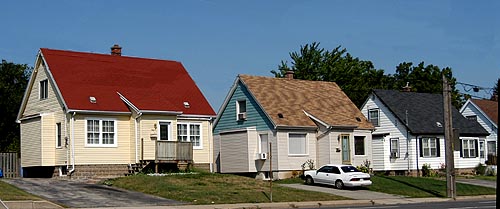
REEVE BUTLER TOOK ON a huge task to ensure there were enough ‘Victory Homes’ for veterans returning home. File photo.
Former Etobicoke reeve and funeral home owner Frank A.C. Butler is best remembered for building hundreds of homes for veterans returning from the war during his three-years in office.
Little is known about Butler, who is the former owner of Butler Funeral Home, which is now Turner and Porter Butler Chapel.
He was elected the 29th reeve of Etobicoke and served one-term from 1943 to 1946 in a time when elections changed from annually to every second year.
He is credited with expanding the Etobicoke Township Hall in 1946, with additions to the front and rear of the building. The hall still stands today in the Burnhamthorpe Rd. and Dundas St. W. area.
Butler is known foremost for his work in housing veterans returning home from the Second World War.
Under his tenure military housing, then known in government advertising as ‘Victory Homes,’ or ‘Stawberry Box’ homes, were built by the hundreds in Alderwood and The Queensway and Royal York Rd., areas.
More than 200 homes were built in the Queensway park area for workers and veterans. They were favoured since they were quick to build, had simple plans that were repeated nationwide.
Hundreds of the dwellings were built in 1943 in the Alderwood area for workers at the Canadian military Small Arms Company, in what is now Marie Curtis Park.
The homes were prefabricated and shipped to the sites to be constructed. This resulted in very homogenous and uniform developments that sprung up in almost every major city during the war and post war periods.
The houses were often one and a half stories tall with gabled roofs and clapboard siding. The streets of these instant neighborhoods were often given names that recalled their place in the time following the war, such as Victory or Churchill.
The typical style was either a detached bungalow or a two-storey semi-detached. Depending on the locale, the facade may have been plain wood or brick, with entrances at the front and sides.
Some 46,000 of the homes were constructed nationwide under the Veterans’ Land Act of 1942, which was initiated by the Canadian Government to provide housing for veterans returning home and their families.
The main objective was to get people working, by giving them land to farm in order to provide for themselves. The homes were very small to allow for a large portion of the property to remain open for potential farming.
Local advisory committees were recruited ‘to advise on potential or proposed sites, to help negotiations for property acquisitions and in a call for tenders.”
There was an assembly line of construction workers, with each team performing one job, then moving on to the next home. With on-the-spot prefabrication, each home took about 36 hours to raise. The wiring, plumbing, and interior finishing were completed, including more insulation. A fuel box for heating stoves was attached to the house exterior, to hold perhaps wood or coal.
The compact homes were rented for $22 to $30 monthly, affordable for workers and war-weary veterans. Thanks to historian Denise Harris.